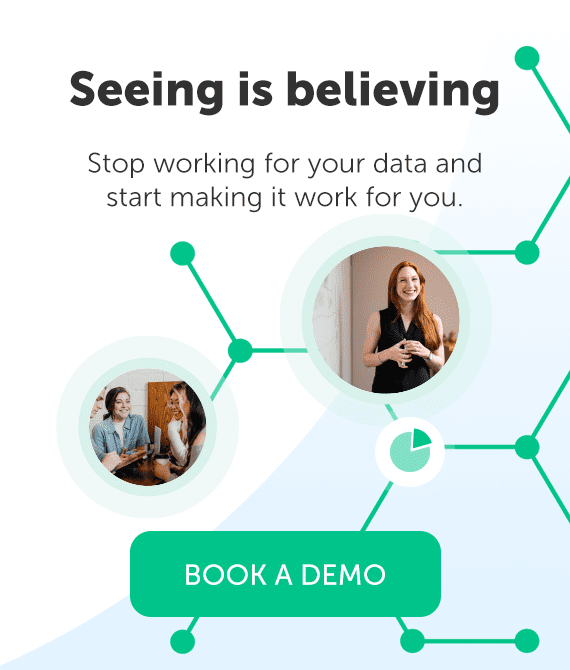Winning new business is rarely straightforward. On the client side, there are often eight to 13 stakeholders involved, and they don’t all engage the same way. Your team’s expertise matters, but it’s trust and credibility that really set your firm apart. A warm introduction from someone the client already knows can often carry more weight than a logo-filled pitch deck or a hundred-page RFP response.
That’s why business relationship mapping is such a valuable tool. Many firms turn to org charts, internal prep sessions before a pitch, or notes in a CRM to figure out who knows who. The problem is that these maps are static. They capture a moment in time but quickly lose relevance when a champion moves, a new decision maker arrives, or reporting lines shift inside the client organization.
A more effective approach works like a GPS: continuously updated, recalculating the best routes, and signaling when a new, warm pathway becomes available.
Table of contents
Relationship mapping 1.0: the static blueprint
What it is
The first generation of business relationship mapping was manual and fragmented. Your professionals sketched org charts in PowerPoint or Visio, pieced together contacts from memory, and pulled what they could from disconnected spreadsheets or CRM records. These types of relationship mapping tools offered a snapshot of the client organization but rarely delivered a view of the full breadth and strength of your relationships that was current or complete.
The inherent flaws
Static maps have four major shortcomings that limit their usefulness:
- Short shelf life: they lose accuracy as soon as people change roles, new stakeholders emerge, or reporting structures shift.
- Fragmented knowledge: much of the insight sits in individual inboxes, personal networks, or one partner’s head, making collaboration across the firm difficult.
- Shallow context: traditional maps show titles and reporting lines but fail to capture the strength, trust, or influence behind a connection, limiting the value of stakeholder mapping.
- Reactive by design: they tell you what the account looked like at one point in time, but they don’t surface signals that guide your next move.
The tipping point: why a dynamic approach is now essential
The pressures facing firms of all sizes are intensifying. Clients are reshaping teams more frequently, senior leaders are moving roles faster, and buying decisions hinge less on formal RFPs and more on trusted pathways. In this type of environment, static business relationship mapping tools do more harm than good. This form of stakeholder mapping creates blind spots at exactly the moments when influence is shifting and competitors are finding their way in.
Increased job mobility
When a long-standing champion leaves an account, the entire picture of influence can shift overnight. Champions you’ve nurtured for years often change roles, join competitors, or step into leadership positions at target accounts. Executive turnover is rising, and average tenure in senior roles is shrinking. In parallel, many organizations are deliberately moving talent across functions to broaden experience. The result is constant role fluidity, and static maps or outdated stakeholder mapping techniques can’t keep pace with the changes, making it harder to sustain momentum toward strategic account growth or reliably find new business.
The rise of relationship-based selling
Winning new business is no longer just about identifying the decision maker at the top of an org chart. Clients expect you to come with context and credibility already established. A referral from a shared board seat, a connection through a former employer, or insight from a trusted colleague can create the warm path to a decision maker that a cold approach will never match.
Research from Deloitte underscores this shift, showing that client trust depends on consistent, multi-stakeholder relationships rather than transactional interactions, a dynamic that static business relationship mapping fails to capture.
In the legal sector, for example, clients are demanding more active relationship management as procurement becomes more competitive and buyers shop firms more aggressively. The same dynamic plays out in accounting and consulting, where trust-based pathways often determine whether your firm is seriously considered or quietly sidelined. Static org charts miss these nuanced connections, leaving you guessing and giving your competitors the opportunity to move in with stronger relationships and a clearer path to decision maker conversations that can detail your firm’s strategic account growth plans.
Relationship mapping 2.0: introducing automated pathways & champion tracking
The “Pathways” engine: illuminating every route to an opportunity
Introhive’s Pathways moves beyond the limits of static org charts and surface-level CRM records. It automatically uncovers relationship pathways across your firm, highlighting not just direct connections but also second-degree ties rooted in shared experiences. These are the kinds of overlaps that build instant credibility and create natural reasons to connect.
For example, a prospect’s CFO may have once worked for the same consulting firm as one of your senior partners, creating a natural entry point. Or an in-house counsel you are targeting may have earned their MBA from the same business school as several people in your firm, making an alumni angle an easy opener and setting up a natural warm introduction that helps your team find new business opportunities.
By analyzing firm-wide interactions and scoring these overlaps, Pathways enhances stakeholder mapping by showing not just who is in the org chart but where authentic pathways exist, while also prioritizing the warm introduction that’s most likely to open doors.
The “Champion Tracking” signal: your proactive growth alert
At the heart of nearly every successful pursuit is a champion inside the client organization who knows your value and is willing to advocate for you. The challenge has always been keeping track of these champions as their careers progress.
Champion Tracking solves this problem by giving you visibility into key contact moves and sending real-time signals when they happen. If a long-time audit client takes on a CFO role at a fast-growing portfolio company, you know immediately, giving you the chance to congratulate them and discuss their new priorities. If a trusted in-house counsel steps into a senior role at another organization, you can both reinforce relationships with other stakeholders at the existing client so you are not overly reliant on a single point of contact, while also positioning yourself to support your champion in their new role.
By the time most teams notice a champion has left, the client relationship has already weakened. Champion Tracking surfaces those moves right away, giving you the chance to reinforce existing ties and re-engage with your contact in their new role, and ensure those transitions become opportunities to support long-term strategic account growth.
Putting it to work: 3 strategies powered by next-gen relationship mapping
Pathways and Champion Tracking work best when applied together. They give you a clearer view of your network and the signals you need to act at the right time. These three strategies show how firms are using them to drive growth, accelerate pursuits, and protect key accounts, making them a critical part of your growth strategy.
Penetrate “whitespace” accounts
When a former client contact moves into a leadership role at a target account, Champion Tracking alerts you immediately. That career change creates an opening that would otherwise take months to uncover. With Pathways, you can see the most natural route back in, turning what would have been a cold start into a warm re-entry built on trust, and one of the most effective ways to find new business.
Open the right doors, sooner
Complex pursuits often slow down when you are forced to navigate gatekeepers. Pathways streamlines stakeholder mapping by helping you identify shared connections like a past employer, an alumni network, or a board affiliation that can provide a warm introduction and a direct path to decision maker engagement. With that context, your outreach carries more weight and conversations move forward faster.
Mitigate client risk
Relying too heavily on a single champion leaves accounts vulnerable. Champion Tracking notifies you the moment a key contact leaves so you can strengthen ties with other stakeholders before competitors step in. At the same time, you can follow your champion into their new position, balancing account protection with the potential to create a new opportunity that fuels long-term strategic account growth.
The future is proactive, not reactive
The era of static relationship map tools and manual effort is ending. Hours spent building org charts or chasing updates in a CRM result in a snapshot that is outdated almost as soon as it is complete. Growth today requires a different approach, one that adapts as quickly as your clients and prospects do.
Next-generation business relationship mapping is about more than seeing who you know. It gives you timely signals and a clear path to decision maker connections that show you where to go next. With Pathways and Champion Tracking, Introhive equips firms to anticipate opportunities, safeguard key accounts, and act with confidence when it matters most.
Instead of relying on static relationship mapping tools, you have a living system that updates in real time, highlights the strongest pathways, and alerts you when new openings appear. Every firm is committed to growth, but the ones that succeed are those that build it on trusted relationships and the warm introductions that open meaningful conversations.
Ready to see how Introhive can help your firm turn relationships into growth? Book a demo today.
Or, if you prefer to explore it for yourself, try the interactive demo of Introhive’s Intelligence Suite and experience Pathways and Champion Tracking in action.





